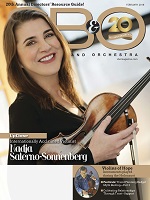We may achieve variety in many ways within a musical arrangement. This example is taken from an arrangement that I did for the opening of the Thanksgiving Parade in Philadelphia for WPVI (ABC-Disney); O Come All Ye Faithful.
It is scored for eleven instruments; three trumpets, two trombones, three saxophones, and three rhythm (piano, bass, and drums). I considered beginning the arrangement with a brass quartet ala chorale-style, but felt that three musical lines moving at different speeds would accumulate the needed tension and momentum, that the parade opening required. These three lines, (in a musical conversation), lead to a forte ensemble passage beginning in m.11 that builds in intensity.
Not only ,does the texture vary from three unison lines to divisi, but the rhythm section also begins to swing in 4/4 time. Notice that the three characteristics of a good arrangement take place within this short excerpt; 1. Transparency of texture (three unison lines moving at different speeds ( mm. 3-10), 2. Variety of tone color (unison building to an ensemble passage), and 3. Contrapuntal lines building to a climax. Recognize that these characteristics occur again later in the arrangement beginning at m. 20.
It is important to note that the slowest-moving line (melody) is assigned to unison trumpets, while unisontrombones are added and play a contrapuntal line that moves a bit faster than the trumpet line. Below all of this is a fast-moving part in eighth notes for the bass, which is introduced two measures before the trumpets enter.
All three lines combine to form a conversation among the three sections. The saxophone section is silent until m 11. Doubling the saxophones on a line at the beginning, would threaten the clarity and purity of the brass sound, and would have an adverse affect on the flexibility of the arrangement.
Also notice at m 11 that the saxophones play a unison line against divisi brass. This unison line adds focus and direction to the sound, and the fact that it moves in contrary motion to the brass makes it even more appealing. I have found it useful to double the lead trumpet at the lower octave using another trumpet or a trombone, whenever the lead trumpet plays above Bb concert (above the staff). This doubling at the lower octave reinforces the overtones of the high trumpet and adds brilliance and energy to the sound.

Example 1. O Come All Ye Faithful arranged by Vince Corozine (Notice that all instruments are in concert key, with the bass sounding one octave lower)
(This arrangement may be heard on Vince’s Web page: www.vincecorozine. com)
One will discover that the saxophones play unison counterpoint lines for most of the arrangement, except in measure 14 and the last three measures of the arrangement where they are divided to add fullness to the brass chords. Notice the alternating of the tenor and baritone saxophone notes in m 15. (Repeated notes have a tendency to be diffi cult to play and do not “swing.”) Having the saxophones play divisi throughout would make the arrangement sound too thick and cloying, and destroy the fl exibility of the moving lines. A constant “tutti” sound lacks in contrast – ie: the big-sounding sections sound even bigger when they follow unison lines.
What clearly emerges is the fact that unison lines are used almost as much as divisi lines. In fact, in this arrangement there are twelve measures of unison while divisi totals only fourteen measures. Musical lines (particularly those that move in contrary motion).
are more engrossing for the musician to play, and are more appealing to the listener, than are constant divisi chords. This constant divisi wears on the ear and quickly becomes tiresome to the listener. Unison lines provide contrast for the listener, and when the brass divisi does appear, the effect is even more varied and impressive.

A word about voicing brass chords. Making three trumpets and two trombones sound like a much bigger ensemble is possible if one adheres to the following guidelines:



























